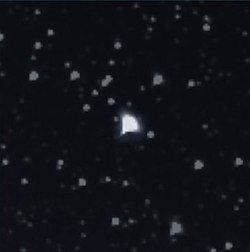HD 21749
 HD 21749 – star in the constellation Reticulum | |
| Observation data Epoch J2000 Equinox J2000 | |
|---|---|
| Constellation | Reticulum[2] |
| Right ascension | 03h 26m 59.22s[1] |
| Declination | −63° 29′ 56.9″[1] |
| Apparent magnitude (V) | 8.143[3] |
| Characteristics | |
| Spectral type | K4.5V[4] |
| Astrometry | |
| Radial velocity (Rv) | 59.46 ± 0.12[5] km/s |
| Proper motion (μ) | RA: 355.084[5] mas/yr Dec.: −247.460[5] mas/yr |
| Parallax (π) | 61.2455 ± 0.0264[5] mas |
| Distance | 53.25 ± 0.02 ly (16.328 ± 0.007 pc) |
| Details | |
| Mass | 0.68 M☉ |
| Radius | 0.76 R☉ |
| Temperature | 4571 K |
| Other designations | |
| Database references | |
| SIMBAD | data |
| Extrasolar Planets Encyclopaedia | 21749 data |
HD 21749 (HIP 16069, 2MASS J03265922-6329569) is an orange main-sequence star[4] about 0.68 the mass of the Sun in the constellation Reticulum, located about 53 ly (16 pc) from Earth.[2] On 7 January 2019, it was announced that the star has two exoplanets: a possibly rocky, hot sub-Neptune-sized exoplanet, named HD 21749b; and, a sub-Earth exoplanet, tentatively named HD 21749c (aka, TOI-186.02).[2][6][7] These exoplanets were discovered by the Transiting Exoplanet Survey Satellite (TESS).[2]
Stellar characteristics[]
HD 21749 is a star that is approximately 68% the mass of and 76% the radius of the Sun. It has a surface temperature of 4571 K.[1] In comparison, the Sun has a surface temperature of 5778 K.[8]
The star's apparent magnitude, or how bright it appears from Earth's perspective, is 8.143.[3]
Planetary system[]
HD 21749 has two known planets orbiting around it:[2] HD 21749b is a confirmed hot Neptune-sized, possibly rocky, exoplanet
HD 21749c is a super-Earth-sized exoplanet[2] with period 7.8 days.[9]
| Companion (in order from star) |
Mass | Semimajor axis (AU) |
Orbital period (days) |
Eccentricity | Inclination | Radius |
|---|---|---|---|---|---|---|
| c[6][7] | <3.7 M |